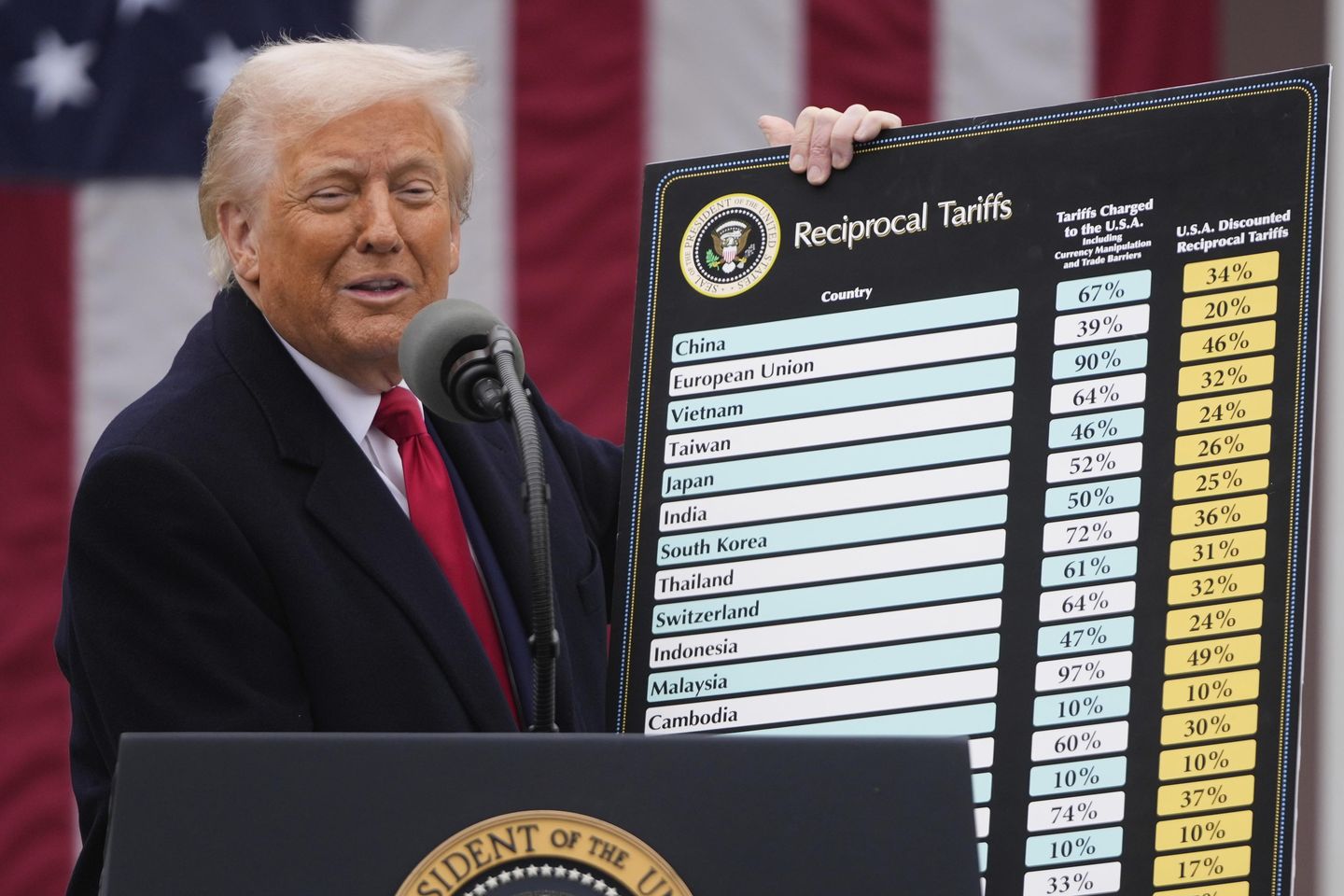
President Trump has escalated his global trade offensive this week, armed with confidence that the import levies will deliver manufacturing jobs and stronger growth in the U.S., along with declining concerns about inflation.
More than $98 billion in tariff revenue has flowed into the federal government as of Monday, according to the latest Treasury Department numbers. That marks a 110.5% increase in U.S. tariff revenue from the same time last year.
Treasury Secretary Scott Bessent said this week that tariff revenue could exceed $300 billion by the end of the calendar year. If Mr. Bessent’s prediction proves true, that would mean tariff income would blow past the $200 billion estimate forecasted by the Committee for a Responsible Federal Budget, economists at Moody’s and others.
At the same time, companies are not passing off some of the tariff costs to consumers at the levels forecasted, preventing inflation from rising.
The Consumer Price Index, a key measure of inflation, eased in May compared to the previous month, according to the Labor Department’s most recent statistics. Prices for a broad measure of goods, excluding food and energy, rose by 0.1% for the month, bringing the annual inflation rate to 2.4%. The inflation rate was 3.3% in May 2024.
Alex Salter, an economist at Texas Tech University, said the inflationary aspects of the tariffs were always overblown.
“When you tax something, the price of it goes up, but imports are only about 15% of the U.S. economy, so when you raise the average tariff rate, that is really not enough to drive sustained dollar depreciation,” he said. “I think at most you would get a one-time price increase for the affected goods, but the overall inflationary consequences are going to be pretty small, like a blip.”
On top of all that, the cost to export goods into the U.S. dropped by 0.9% in May, according to the Bureau of Labor Statistics. That’s the largest decline since October 2023 and much larger than Wall Street’s expectations, which had anticipated a 0.2% decrease.
The decline was driven by a sudden drop in the export price of automobiles. For example, the price of Japanese vehicles delivered to North America has plummeted by 17.7% from March to May, according to the Bank of Japan.
China, which was hit the hardest by additional tariffs, has lowered the prices of its exports to the U.S., with the price of Chinese products falling by about 2% across all industries from December to May, according to the Labor Department. In June, the U.S. and China started to finalize a trade deal.
The flurry of good news has left some doomsayers issuing a mea culpa.
Goldman Sachs chief economist Jan Hatzius said it is too early to declare victory, but acknowledged the impact of the tariffs was smaller than expected. At the end of June, the investment bank said the lack of inflation could lead the Federal Reserve to cut interest rates later this year.
However, others caution that the full impact of Mr. Trump’s tariff policy remains to be seen because it has not been implemented to the extent the president had sought. Ryan Young, senior economist at the Competitive Enterprise Institute, said it’s too soon to judge its effects.
“The increased revenue is enough to offset inflation, but the effect is so small that it is deep decimal territory and unlikely to show up in the Consumer Price Index,” he said. “In six months, you could be paying a higher price for goods, and if you are a retailer, you are still trying to decide where to set your prices. That kind of uncertainty is also having a mixed effect on prices.”
With the combination of easing inflation and increased revenue, Mr. Trump is still bullish on tariffs. This week, he dashed off letters to the heads of at least 28 countries informing them of new tariff rates. At the same time, he gave each country extra time to reach a trade deal by extending the date for tariffs to Aug. 1.
The steep tariffs spelled out in Mr. Trump’s letters essentially replace the original set of levies Mr. Trump announced for virtually all of America’s trading partners in April, but he paused in early July to quell a tumultuous stock market and negotiate trade deals around the globe.
Japan, South Korea, the Philippines, South Africa, Laos, Sri Lanka, Libya and Iraq were among the recipients from Trump’s letters announcing they will now face tariffs ranging from 17% to 40%. The highest rate Mr. Trump threatened was 50% on goods from Brazil.
Many of the countries swiftly responded. Japanese Prime Minister Shigeru Ishiba expressed “regret” that the U.S. would impose additional tariffs and vowed to continue negotiations. Other nations voiced their desire to keep negotiating.
Perhaps the most fiery response came from Brazilian President Luiz Inacio Lula da Silva, who vowed to match any tariffs imposed on his country’s imports by the U.S.
In a post on X, Mr. da Silva responded to the 50% levies on all Brazilian imports by threatening that “any unilateral tariff increases” would be met with reciprocal tariffs on U.S. goods.
He stressed that Brazil is “a sovereign country with independent institutions and will not accept any tutelage.”
The U.S. is Brazil’s second-largest trading partner after China, so the tariff hike from 10% to a whopping 50% if it can’t reach a trade deal threatens to jar the South American nation’s economy.
The U.S. president said the tariff was partly in retaliation for the prosecution of former Brazilian President Jair Bolsonaro.
Addressing Mr. Trump’s assertion, Mr. da Silva said that the matter was the “sole responsibility” of the Brazilian judiciary and shouldn’t be subject to outside interference that “undermines the independence of national institutions.” He added that he “will not accept being lectured by anyone.”
The American president has long decried Brazil’s treatment of Mr. Bolsonaro, a vocal ally of Mr. Trump standing trial over his role in an alleged coup to overturn his 2022 reelection loss. Mr. Trump has described the criminal case against Mr. Bolsonaro as “an international disgrace” and slammed the trial as a “witch hunt,” echoing the language he used to describe the multiple criminal investigations he faced.
The letter to Mr. da Silva followed more than two dozen others Mr. Trump sent this week to other world leaders, dictating steep tariff rates on goods they sell to the U.S.
In his letter to Brazil, Mr. Trump wrote that the country’s trade policies have caused “unstable trade deficits against the United States,” threatening its economy and national security.
Yet the U.S. had a trade surplus with Brazil of $7.4 billion in 2024, according to the Office of the U.S. Trade Representative.
In his response, Mr. da Silva called the allegation of a trade deficit false, citing the U.S. government’s statistics.














